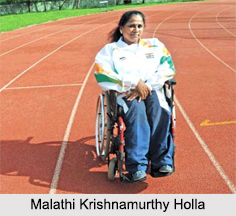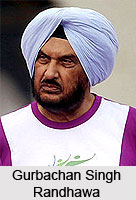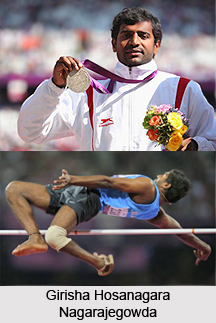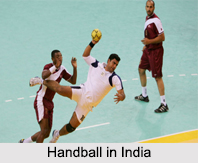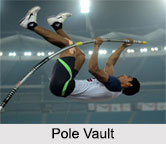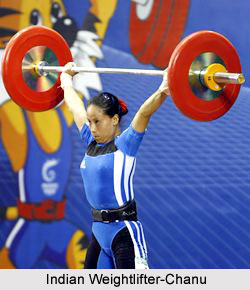 Rules of weightlifting help to make the game simpler and transparent for the athletics. The rules for the game can be divided into various parts for the simplicity of the same. In the game a lifter can two types of lifts to choose from. The international body recognises the following two lifts namely; the snatch and the clean & jerk. These lifts must be executed with both the hands and only three attempts are allowed in each type of lift
Rules of weightlifting help to make the game simpler and transparent for the athletics. The rules for the game can be divided into various parts for the simplicity of the same. In the game a lifter can two types of lifts to choose from. The international body recognises the following two lifts namely; the snatch and the clean & jerk. These lifts must be executed with both the hands and only three attempts are allowed in each type of lift
Snatch
The bar is placed horizontally in front of the lifter`s legs. It is gripped PALMS downwards and pulled in a single movement from the ground to the full extent of both arms above the head, while either splitting or bending the LEGS. The bar passes with a continuous movement along the body. No part other than the feet may touch the ground during the execution of the lift. The weight which has been lifted must be maintained in the final motionless position, arms and legs extended, the feet on the same line, until the referee gives the signal to replace the bar on the platform.
Incorrect movements are - pulling from the hang, uneven or incomplete extension of arms, pausing during execution of arms finishing with a press out, bending and extending arms during recovery leaving the platform or touching the area outside the platform, replacing the bar on the platform before the referee`s signal, dropping the bar from behind after the referee`s signal, failing to bring the feet and on barbell in the same line and failing to replace the complete barbell on the platform.
Clean and Jerk
The Clean: The bar is placed horizontally in front of the lifter`s legs. It is gripped, palms downwards and pulled in a single movements from ground to the shoulders, while either splitting or bending the legs. During this continuous movement, the bar may slide along the thighs and the lap. The bar must not touch the chest before the final position. It then rests on the clavicles (collar bones) or on the chest above the nipples or on the arms fully bent. The feet return to the same line, legs straight, before performing the Jerk.
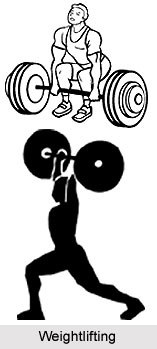 The Jerk: The lifter bends the legs and extends them as well as the arms so as to bring the bar to the full stretch of the arms vertically extended. He returns the feet to the same line, arms and legs extended, and wait for the referee`s signal to replace the bar to the platform.
The Jerk: The lifter bends the legs and extends them as well as the arms so as to bring the bar to the full stretch of the arms vertically extended. He returns the feet to the same line, arms and legs extended, and wait for the referee`s signal to replace the bar to the platform.
Incorrect movements are - any unfinished attempt in which the bar has reached the height of the knees, pulling from the hang, touching the ground with any part of the body other than the feet, uneven or incomplete extension of arms, pause during extension of arms, finish with a press out, bending and extending arms during recovery, leaving the platform or touching the area outside the platform during the lift, replacing the bar on the platform before the referee`s signal, dropping the bar before the referee`s signal, dropping the bar from behind, failing to finish with feet and barbell in the same line and failing to replace the complete barbell on the platform, touching the elbow or upper arm with knee or thigh, apparent effort of jerking which is not completed and any deliberate oscillation of the bar to gain advantage.
Important Rules of Weightlifting
1. Draw of lot: At the technical meeting a number is drawn for each lifter. This number is retained throughout the competition even if a lifter moves to a higher category. It decides the order of weigh-in and the order of lifting.
2. Weigh-in begins 2 hours before the start of the competition of a particular category and lasts for one hour. They have one hour from the start of the weigh-in to make the required limit. A lifter heavier than his category may move to the next higher category if there is a vacancy. Lifters are weighed nude or in underwear.
3. Weight of the barbell must always be multiple of 2.5 kg. The progression must be of a minimum of 2.5 kg in the 2nd or 3rd attempt.
4. A minute and a half is allowed to a lifter between calling of his/ her name and beginning of the attempt. Within this time the lifter must raise the bar from the platform to make the attempt. When a lifter attempts 2 lifts in succession he/she is allowed 3 minutes for the succeeding attempt.
5. The barbell is loaded in progression, a lifter taking lowest weight lifting first. Under no circumstances may the barbell be reduced to a lighter weight when a competitor has performed a lift with the weight announced.
6. The highest weight lifted in the two styles is added together and the lifter with the highest total is the winner.
7. In case of a tie a lighter competitor is classified before the heavier one.
8. When two or more competitors obtain the same result where they registered the same body-weight, the competitor who reaches the result earlier in the course of the competition is classified before the other one (s).
9. A jury is selected which ensures that the technical rules are followed and the referees work correctly.
10. The referees check up all equipment, control the competition, judge every lift and indicate their decision by light signals





